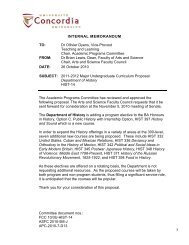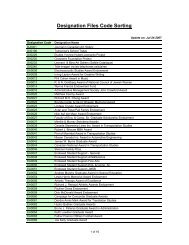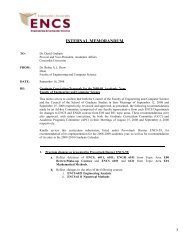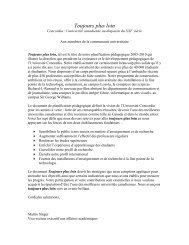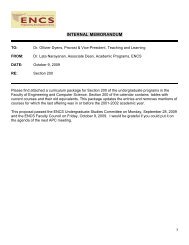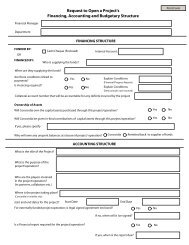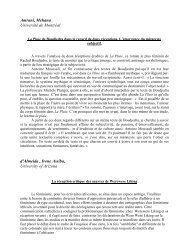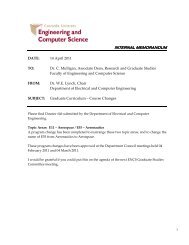Susan Landau-Chark - Concordia University
Susan Landau-Chark - Concordia University
Susan Landau-Chark - Concordia University
Create successful ePaper yourself
Turn your PDF publications into a flip-book with our unique Google optimized e-Paper software.
The Story of One Suburban Synagogue and its Founding Rabbi<br />
---<strong>Susan</strong> <strong>Landau</strong>-<strong>Chark</strong>---<br />
Rabbi Abraham Bernard Leffell was a rarity amongst Canadian rabbis in his day.<br />
He was a first generation Canadian - born in Montreal, June 12, 1926, with both his<br />
parents having migrated to North America at a very young age. 1 In order to fully fathom<br />
the milieu within which Rabbi Leffell spent his rabbinical career it is important to be<br />
aware of further divergences between Canada and the United States especially in regard<br />
to the suburbanization of their respective Jewish communities.<br />
One striking variation between the American immigration experience and that of<br />
immigrants to Canada was that while many of the immigrants and their children<br />
“Canadianized” they continued to maintain their traditional religious practices. By the<br />
1950's in both Canada and the United States, the demobilization of the armed forces and<br />
the influx of new immigrants contributed to this period of time as being one of intense<br />
preoccupation with conformity. In the United States, “Levittowns” were being built and<br />
families were rushing from the cities to the suburbs to live in these look-alike houses.<br />
Women were in the suburbs with the children, family size increased, men were in their<br />
grey flannel suits climbing the corporate ladder, and the key word to family life was<br />
“togetherness.” 2<br />
The legendary family of the 1950's, complete with appliances, station<br />
wagon, backyard barbecues and tricycles scattered on the sidewalks<br />
1<br />
Who’s Who in Canadian Jewry, ed. Edmond Lipsetz (Downsview, ON: JESL<br />
Educational Products, 1989): 158. Also email received from J. Leffell, September 12,<br />
2004.<br />
2<br />
Chafe, William, The Paradox of Change: Women in the Twentieth Century (New York<br />
and Oxford: Oxford <strong>University</strong> Press, 1992): 188.
2<br />
represented ... the first whole-hearted effort to create a home that would<br />
fulfill virtually all its members personal needs through an expressive and<br />
energized personal life. 3<br />
Like similar communities all over North America after World War Two, young Jewish<br />
families were part of this exodus from the older sections of the city to the suburbs. In<br />
Vancouver, they moved from the east-end immigrant quarter to the newer, lower-middleclass,<br />
west-side neighbourhoods; in Winnipeg, Jews moved out of the old north end to the<br />
adjacent area of West Kildonan and southward into River Heights. They built<br />
synagogues, schools and social facilities, replacing virtually all of the previously existing<br />
institutional networks. In Toronto, the main Jewish migration pushed up Bathurst Street<br />
past St. Clair, Eglinton, and Lawrence, while in Montreal, the biggest movement was<br />
from Outremont over the mountain into Côte Des Neiges, Notre Dame de Grace, and the<br />
western suburbs of Saint-Laurent, Chomedy, Dollard des Ormeauxand Cote St, Luc.<br />
The realities of Canadian suburbanization distinguished itself in several<br />
waysfrom the “given North American paradigm.” Canada’s history with France had<br />
shaped a centralized urban system in Quebec, whereas Canada’s history with England<br />
shaped a decentralized urban system in Ontario. The slower growth of the Canadian<br />
population and economy permitted more orderly urban growth. This kept a number of<br />
urban centres intact and avoided the decayed zones of America’s major cities. This also<br />
allowed for the gradual growth of the suburbs. Moving over the mountains to NDG or<br />
CDN or up Bathurst street towards Cote St Luc or Thornhill seeded these areas with<br />
communities that continue to exist today. In Canada it was as often the workers who<br />
3<br />
Laura J. Miller, “Family Togetherness and the Suburban Ideal,” Sociological Forum, V.<br />
10, #3 (1995):401. Miller is quoting Elaine Tyler May, Homebound: American Families<br />
in the Cold War Era (New York: Basic Books, 1988):11.
3<br />
moved from the urban areas for cheaper housing, as well as the burgeoning middle-class.<br />
Most American suburban Jewish communities formed Conservative synagogues.<br />
By 1956, in the United States, there were 599 conservative synagogues - an increase of<br />
65% from 1949, when there were 365 Conservative synagogues. Albert Gordon, a<br />
Conservative rabbi as well as a professor of anthropology, was curious about the fact that<br />
young Jewish couples, whom he called “seekers of the good life,” were establishing<br />
themselves in America’s suburban communities in vast numbers. He undertook a three<br />
year research project that covered 89 American suburban Jewish communities. His<br />
study, Jews in Suburbia, was completed in 1959. 4 Gordon was concerned with how the<br />
acculturation of suburban Jews might adversely affect the Jewish family and by<br />
extension, the Jewish community. He noted that the suburban synagogue had however,<br />
become the most important Jewish institution, as families tended to affiliate as soon as<br />
their children were old enough to attend Hebrew or Sunday school.<br />
During these years after the war, all families, Jewish and non-Jewish, sought<br />
collective involvement in a religious social life. In the 1950's and 60's in North America,<br />
a billion dollars were raised to build 1000 new synagogues. 5 Tulchinsky noted that in<br />
Canada, between 1945 and 1952, eight million dollars was spent on synagogue<br />
development. 6 In his article, “Two Centuries of Jewish Life in Canada” Louis Rosenberg<br />
further noted that in 1935 throughout Canada there were 152 Jewish congregations of<br />
which 140 were Orthodox, 9 were Conservative, and 3 were Reform. 7 By 1960 there<br />
4<br />
Albert Gordon, Jews in Suburbia (Boston: Beacon Press, 1959).<br />
5<br />
Arthur Hertzberg, The Jews in America: Four Centuries of an Uneasy Encounter: A<br />
History (New York: Columbia <strong>University</strong> Press, 1997): 309.<br />
6<br />
Gerald Tulchinsky, Branching Out: The Transformation of the Canadian Jewish<br />
Community (Toronto, ON: Stoddart Publishing Co., Ltd, 1998): 278.<br />
7<br />
Louis Rosenberg, “Two Centuries of Jewish Life in Canada,” in Canadian Jewish
4<br />
were 206 congregations of which 174 were Orthodox, 25 were Conservative and 7 were<br />
Reform. 8 Rosenberg commented that this “rise in synagogue building and membership<br />
appeared to be motivated by a desire to “belong” rather than [by] a strong religious<br />
conviction.” 9<br />
In Montreal’s West Notre Dame de Grace, by 1951, there was a large enough<br />
Jewish population to prompt consideration for a building that would house a synagogue<br />
(soon to be named “Shaare Zion”), a Hebrew school, and a community hall. 10 In July of<br />
1951 the initial group of 16 families had expanded sufficiently to elect officers and<br />
organize into the Jewish Congregation of Western N.D.G. 11 On April 2, 1952, the<br />
congregation was incorporated under the Companies Act of Canada.<br />
In Gordon’s observation of the families moving to the American suburbs, he had<br />
expressed concern that many of these families were joining their synagogues in order to<br />
“socialize” with other Jews rather than because of any perceived connection with Jewish<br />
tradition. Many of the group in Western N.D.G. grew up within a traditional Jewish<br />
setting but were now seeking a more modern approach to Judaism for themselves and the<br />
families they were forming. This group very much saw itself as a community, and wanted<br />
to be seen that way by others. They hoped to attract members by emphasizing not only<br />
the community’s friendly and hospitable environment, but also the fact that their services<br />
were structured and decorous unlike the remembered services, for many, of their<br />
childhood.<br />
Reference Book and Directory, ed. Dr. Elie Gottesman, (Montreal, QC: Central<br />
Rabbinical Seminary of Canada, 1965): 189.<br />
8<br />
Ibid. 189. In Montreal by the 1960's there were 48 Orthodox synagogues, 4<br />
Conservative and 3 Reform synagogues.<br />
9<br />
Ibid. 190.<br />
10<br />
Shaare Zedek Souvenir Book. 1955: 4<br />
11<br />
Shaare Zedek Souvenir book. 1955: 4
5<br />
While Rabbi Leffell was still a rabbinical student, he was asked to conduct the<br />
High Holiday overflow services at the newly completed Shaare Zion synagogue. 12 He did<br />
so for two years. A number of the families who lived in Western NDG attended the<br />
overflow service in those years. When this group decided to have its own High Holiday<br />
Service they remembered the eloquent young rabbinical student and asked him to conduct<br />
their services. It was a matter of great relief and excitement when on June 21 st , 1953 the<br />
congregation and others witnessed the ceremonial turning of the sod on the synagogue’s<br />
present site. 13 Rabbi Leffell was now in his senior year at JTS.<br />
Shortly after his ordination in the summer of 1954, Rabbi Leffell was invited to<br />
“undertake the organization and leadership” of a new synagogue being built in the northwest<br />
sections of the city of Montreal known as Western Notre Dame de Grace. 14 He was<br />
formally installed in September 1954 and was with the congregation until he retired, 37<br />
years later, in October 1991. 15<br />
Rabbi Leffell struck a cord with his audience and grasped the “needs” of this new<br />
community. Most of his audience were young families who had moved into the new<br />
housing being built in Western N.D.G. While they were not affluent, many of them were<br />
able to purchase homes in the area around the synagogue.<br />
12<br />
Op Cit. Retirement Address. 3; also in conversation with Mrs. F. Leffell (October 21,<br />
2004).<br />
13<br />
Ibid. p.6<br />
14<br />
Harvey Shepherd, “N.D.G. Rabbi sees big changes over Career,” The Gazette<br />
(September 28, 1991): L-5.<br />
15<br />
Ibid. Last spring it came to my attention that Rabbi Leffell’s papers and notes had not<br />
yet been archived but were in the care of his eldest son Jonathan Leffell. The family had<br />
decided to “burn” all of Rabbi Leffells’s notes and sermons onto CD ROMs which will<br />
be archived with the Jewish Theological Seminary. Jonathan told me that one CD<br />
containing thirty-odd years of sermons on three parshiot (Bereshit, Noach, and Vayera)<br />
was finished, and it is that CD that I have used for this paper.<br />
19<br />
Stanley F. Chyet, “Hebrew Union College- Jewish Institute of Religion,”
6<br />
Let us more deeply examine Rabbi Leffell’s spiritual background. After<br />
graduating from McGill, Rabbi Leffell attended the Jewish Institute of Religion until<br />
1950. Founded in 1922 by Rabbi Stephen Wise, the Institute was seen as a place where<br />
students from a variety of backgrounds could engage in “training for the Jewish ministry,<br />
research and community service.” 19 This openness to those from traditional backgrounds,<br />
as well as the Institute’s pro-Zionist stance seemed a good fit for the young man from<br />
Montreal, hailing from a Jewish community that through to the 1940's, “remained by and<br />
large …. traditional.” 20<br />
When Stephen Wise died in 1949, the merger between the Institute and Hebrew<br />
Union College took place a year later in 1950. 21 Rabbi Leffell transferred to the Jewish<br />
Theological Seminary at this time as he did not wish to be part of the Reform<br />
movement. 22<br />
When Rabbi Leffell moved over to JTS, the teaching staff was a scholar’s list of<br />
‘Famous People’ in the Jewish world. The head of JTS was Louis Finkelstein, president<br />
from 1940, becoming chancellor in 1951 23 , Mordechai Kaplan was on staff, as were Louis<br />
Ginzberg, A.J. Heschel and Saul Lieberman, to name a few. 24<br />
Rabbi Finkelstein saw Judaism as a pivotal force in the establishment of a world<br />
Encyclopaedia Judaica, Volume 8 ( Jerusalem: The MacMillan Company, 1971): 217.<br />
20<br />
Op Cit. Tulchinsky (1998): 25.<br />
21<br />
Op Cit. Chayet 217.<br />
22<br />
Email received from J. Leffell, September 12, 2004.<br />
23<br />
Ibid. p.10.<br />
24<br />
The Seminary at 100: Reflections on the Jewish Theological Seminary and the<br />
Conservative Movement, Ed Nina Beth Cardin and David Wolfe Silverman (New York,<br />
NY: The Rabbinical Assembly and the Jewish Theological Seminary of America, 1987).
7<br />
order “that was characterized by peace, brotherhood, and a deep belief in what was then<br />
referred to as ‘the democratic way’." 25 He saw the Seminary as the single greatest Jewish<br />
institution in the world and, as such, the vehicle for bringing the message of Judaism to<br />
the world. 26 Accordingly, seminary programs were put in place by Rabbi Finkelstein to<br />
teach Judaism to American society, open Jewish studies to the findings of other<br />
disciplines, and most of all to train the Seminary's rabbinic graduates to take on the task<br />
of caring for and nurturing the religious and spiritual well-being of the masses of<br />
Conservative congregants. 27 It was in this open and innovative environment that Abraham<br />
Bernard Leffell received his Masters in Hebrew Letters and his Rabbinical Ordination in<br />
1954.<br />
Rabbi Leffell saw the congregation— now the Shaare Zedek Congregation of<br />
Western N.D.G— through some major changes, implementing the switch from separate<br />
seating (as the synagogue had begun as an Orthodox one) to family seating in 1962 -<br />
along with the shift from the Birenbaum Orthodox prayer book to the Conservative<br />
Siddur of Rabbi Morris Silverman, as well as moving from being an Orthodox-affiliated<br />
synagogue to a middle-of-the-road Conservative congregation. 28<br />
It was very likely that Rabbi Leffell was highly influenced by Rabbi Charles<br />
Bender. Rabbi Leffell was Bar Mitzvah at the Adath Israel and it is highly likely that this<br />
event and/or its preparation was the beginning of a lifelong friendship between he and<br />
25<br />
Michael B. Greenbaum, “Apprenticeship as a Leader,” The Finkelstein Era: Tradition<br />
Renewed, <br />
Copyright © 1998-2003 Jewish Theological Seminary of America. [October 17, 2004]<br />
26<br />
Ibid.<br />
27<br />
Ibid. “Key Initiatives.”<br />
[October<br />
17, 2004]<br />
28<br />
Conversation with Leon Penn, Montreal (October 18, 2004)
8<br />
Rabbi Bender. In his retirement speech Rabbi Leffell paid tribute to Rabbi Bender,<br />
describing him as “my teacher who was most influential with regard to the development<br />
of our Services, and to the Conduct (I am saying this with a capital C) of our services”. 29<br />
Rabbi Bender was trained in England at the Aria College, in Portsmouth,<br />
England. A history of Aria College comments that on the Sabbath, the presence of the<br />
College principal and his students ensured lively services and a well disciplined and<br />
reverent enclave which in turn raised the decorum of congregational members. 30 The<br />
standards of Aria College could be considered influential to the second generation of<br />
Rabbis in Europe and North America. In his Retirement Message, Rabbi Leffell<br />
commented that in the early days of the synagogue many of the members “found this<br />
kind of decorum and organization foreign”. 31 He noted that “disciplined Services were an<br />
important innovation 37 years ago, and that...this was not easy to accomplish because this<br />
was not part of the prior synagogue experience of most of the early members of Shaare<br />
Zedek.” 32 He further noted that “ultimately they came to insist upon it and even to boast<br />
about it.” 33<br />
Decorum, or what Rabbi Leffell and others would call “derekh eretz,” was one of<br />
the core themes running through Rabbin Leffell’s sermons like an undercurrent:<br />
sometimes visible, sometimes hinted at - but always there. In his retirement speech Rabbi<br />
Leffell estimated that over the course of his 41 years as a rabbi he had delivered around<br />
29<br />
Rabbi A. B. Leffell, Retirement Address. Shaare Zedek Congregation, Montreal. (July<br />
1991):6.<br />
30<br />
Ibid.<br />
31<br />
Ibid. 6.<br />
32<br />
Ibid. 6.<br />
33<br />
Ibid.
9<br />
2,050 sermons. 34<br />
Rabbi Leffell discussed many issues, but often his sermons would come back to<br />
the question of behaviour, relationships, and the place (responsibility) of the individual<br />
Jew to his congregation, community and the world. These concerns often related directly<br />
to the themes encountered in parasha Vayera: hospitality, right behaviour, responsibility,<br />
truth, and relationships, to name the few that he emphasized through the years.<br />
It is worthy to consider that at the time that Rabbi Leffell was in training at JTS,<br />
Rabbi Finkelstein persistently addressed the importance of ethical values in his public<br />
remarks. 35 Finkelstein was enamoured of the idea of applying the study of ethics and its<br />
results to the problems of the modern world, and had every expectation that his rabbis-intraining<br />
would carry his concerns into their communities. 36<br />
The Vayera sermon delivered in his first year reflected clearly on issues that he<br />
felt were important in the development of a new community. When Rabbi Leffell<br />
delivered this sermon in November 15, 1954, he chose to deal with the concept of<br />
hospitality in all its fullness. Using Abraham’s behaviour to the three visitors as his<br />
guide, Rabbi Lefell asked his congregation to consider the “real” meaning of hospitality.<br />
Hospitality, he noted, “is primarily more than good manners - it is a spiritual attitude<br />
which described the outreaching of human personality”. 37 Rabbi Leffell then proceeded to<br />
break down for his audience what he meant by this and outlined what he perceived as<br />
three aspects of hospitality.<br />
For Rabbi Leffell “real” hospitality had three aspects: hospitality of the heart,<br />
34<br />
Ibid. 3.<br />
35<br />
Op Cit. Greenbaum.<br />
36<br />
Ibid<br />
37<br />
Leffell, Rabbi A. B. “Vayera” (November 13, 1954): 2. Op Cit. CD-ROM. 2004.
10<br />
hospitality of the mind, and hospitality of the soul. The first aspect, “Hospitality of the<br />
Heart,” was the basic good will one would show to strangers. Unfortunately, noted Rabbi<br />
Leffell, very few people were able to open their hearts long enough to talk with<br />
strangers. It was thus his congregant’s “r duty to learn to meet people half way ... in<br />
order to add to the total friendship in the world.” 38 It should also be kept in mind that<br />
during the time Rabbi Leffell was at JTS, the Seminary had become a center for<br />
interreligious and intercultural dialogue, and that as a Seminary student he was<br />
accustomed to seeing clergy of all faiths in its hallways and dining room. 39 ()<br />
The second aspect of hospitality, “Hospitality of the Mind,” reflected an openness<br />
to new ideas. Rabbi Leffell noted that “adult minds become quickly congealed and closed<br />
to new thoughts.” 40 He equated growth and maturity with a willingness to be “hospitable<br />
to new ideas … [and] grateful for every new truth that comes”. 41<br />
The third and last aspect of hospitality coined by Rabbi Lefell was the<br />
“Hospitality of the Soul.” This particular aspect harkened back to Chancellor<br />
Finkelstein’s statement: “When I pray, I speak to God. When I study, God speaks to<br />
me.” 42 Rabbi Leffell noted that while most people believed in God and were not atheists,<br />
he referred to many as “atheists in practice.” 43 He commented that such people had to “set<br />
up their own zoning laws preventing G-D from moving into their souls”. 44 Thus, how we<br />
treat the other is not only the physical hospitality of offering a hand to cross the street or<br />
38<br />
Ibid. 2.<br />
39<br />
Neil Gillman, “Leadership: Cyrus Adler and Louis Finkelstein.”<br />
<br />
40<br />
Op Cit. 3.<br />
41<br />
Ibid. 3<br />
42<br />
Op Cit. Gillman.<br />
43<br />
Op Cit. 4.<br />
44<br />
Ibid. 4.
11<br />
delivering a meal, but also the passing on of what is important in the tradition --<br />
providing that spiritual hospitality which Rabbi Lefell defined as friendliness, openmindedness<br />
and worshipfulness. 45 To do anything less was to undermine one’s standing<br />
as a Jew. 46<br />
Rabbi Lefell re-iterated a similar theme in his sermon of October 22, 1956 when<br />
he examined in more detail the concept of “derekh eretz” and its place in Judaism. 47 At all<br />
times Rabbi Leffell was seeking to create a community marked by acts of kindness, acts<br />
that illustrated respect and concern: acts, and not words.<br />
For Rabbi Leffell, the phrase “derekh eretz” was used by the rabbis to<br />
demonstrate how Abraham epitomized the “principles of proper conduct”. 48 Abraham’s<br />
behaviour towards his three guests in the book of Genesis was considered to be an act of<br />
“derekh eretz”, defined as “etiquette, good manners, good breeding, courtesy, and<br />
politeness”. 49 In this sermon, Rabbi Leffell took time to reinforce the notion that these<br />
acts that seemed so simple were “not normally seen as part of religion or an aspect of<br />
religion”. 50 With today’s busy lifestyle, there seemed to be less room for what he called<br />
the “niceties” of life. 51 Rabbi Leffell also noted that “the Talmud contain[ed] within it<br />
enough principles of etiquette to compile a book that could rival Emily Post or Amy<br />
Vanderbilt”. 52 He set out very clearly those behaviours that constitute “derekh eretz” for<br />
the Shaare Zedek congregation: 1) when speaking to a person, unless they were a parent<br />
45<br />
Ibid. 5.<br />
46<br />
Rabbi A. B. Leffell, “Vayera.” (October 28, 1961).<br />
47<br />
Rabbi A. B. Leffell, “Vayera.” (October 20, 1956).<br />
48<br />
Ibid. 3.<br />
49<br />
Ibid. 3.<br />
50<br />
Ibid. 5.<br />
51<br />
Ibid. 5.<br />
52<br />
Ibid. 6.
12<br />
or a teacher, they should always be addressed by their name; 2) when you knocked on a<br />
door and someone responded ‘Yes” that meant “wait,” and did not mean “enter”; 53 3) one<br />
should not enter a neighbour’s house without announcing oneself; 4) One should not use<br />
indecent expressions even if more words were required to complete the sentence; 5)<br />
when writing and speaking, one should use ‘he and I’, and not not ‘he and he’; one<br />
should do not interrupt when someone is speaking and not monopolize conversation, and,<br />
lastly, one should forget themselves and think of those around them. 54<br />
This basic theme of “derekh eretz” was woven through nearly all thirty-odd years<br />
of sermons on the three parshiot (Bereshit, Noach, and Vayera) that I received. He<br />
further explored these same principles of human happiness, decency and respect in a<br />
sermon on the wife of Abraham’s nephew Lot. Lefell used the image of Lot’s wife’s<br />
“need to look back” upon the destroyed city of Sodom as his springboard for addressing<br />
some of the possible psychological issues that inhibit people from being open (showing<br />
hospitality of the heart) with the “other.” 55 He asked his congregants not to allow<br />
themselves, like Lot’s wife, to be paralyzed by the past - but to move forward - and to be<br />
both open to positive relationships and to engage with others. 56<br />
Rabbi Leffell was ardent in promoting the synagogue’s relationship with the<br />
United Synagogue Movement. Rabbi Leffell’s notes and sermons on the Seminary and<br />
the United Synagogue, his high regard for these institutions and his frequent calls on the<br />
congregation to participate indicate to some extent that he saw himself as creating new<br />
social and religious possibilities through the synagogue’s relationship with the United<br />
53<br />
Ibid. 6.<br />
54<br />
Ibid. 7.<br />
55<br />
Rabbi A. B. Leffell, “Vayera.” (1958): 2-3.<br />
56<br />
Ibid.
13<br />
Synagogue movement. Certainly in his retirement address he notes that the synagogue<br />
“was blessed with generations of lay leaders who [had] been thoroughly devoted,<br />
absolutely generous in their efforts ... from those very first days.” 57<br />
Earlier I noted that one of Chancellor Finkelstein’s goals for his seminary students<br />
was that they would see themselves as being trained to take on the task of caring for and<br />
nurturing the religious and spiritual well-being their Conservative congregants. 58 As a<br />
Seminary graduate, Rabbi Leffell, and others like him, saw themselves as the<br />
“transmitters” of “the enduring message of Judaism to the world.” 59<br />
Rabbi Leffell’s own involvement in the Conservative movement outside of Shaare<br />
Zedek was an incentive for his congregants. At various times Rabbi Leffell was the<br />
Canadian division vice-chairman of the Rabbinical Assembly, Executive Director of the<br />
local region of the United Synagogue, the Association of Conservative Congregations.<br />
Rabbi Leffell was awarded an honorary doctorate of divinity from the Jewish Theological<br />
Seminary in 1979 for his twenty-five years of service of extra-ordinary involvement with<br />
both JTS and the United Synagogue movement.<br />
The following three sermons are representative of the many sermons he gave on<br />
community involvement. These three sermons were given at different moments in the<br />
synagogues’s life: in 1961, prior to the joining of Shaare Zedek tothe United Synagogue<br />
movement, in 1962, in all probability after the referendum on the synagogue’s affiliation<br />
had taken place, and in 1969, seven years after the synagogue had become affiliated with<br />
the Conservative movement. 60<br />
57<br />
Op Cit. Retirement Address. 7.<br />
58<br />
Op Cit. Gillman.<br />
59<br />
Ibid.<br />
60<br />
Conversation with Leon Penn, Montreal (October 18, 2004)
14<br />
Prior to the United Synagogue convention in 1961, Rabbi Leffell began his<br />
discussion of Vayera by addressing how Abraham, even when recovering from his<br />
“surgery,” rushed to provide hospitality for his guests. Rabbi Leffell noted how even as<br />
preoccupied as he was with his pain, Abraham was able to exert himself and look to the<br />
needs of others. he comments that charity begins at home but does not end there.<br />
Rabbi Lefell’s purpose in setting up this scenario was to inform the congregation<br />
that it needed to morally support all aspects of Jewish communal living, especially the<br />
Seminary and the United Synagogue movement that now included over 700<br />
congregations across the United States and Canada. He noted that “the purpose of the<br />
synagogue is to make us aware of our larger responsibilities and to relate us to them.” 61 In<br />
effect he asked “what other meaning is there in being a Jew if it isn’t our relationship to<br />
the Jewish people” This relationship was to be achieved through a strong connection to<br />
the Conservative movement. 62<br />
The second sermon given in mid-November of 1962 built on the motif of the<br />
Akeda, the Biblical story of the Binding of Isaac. Rabbi Leffell noted that after the Akeda,<br />
“Abraham found within himself the powers of replenishment and endurance to rise from<br />
the crisis and go forth toward greater promise and accomplishment.” 63 Rabbi Leffell<br />
provided a succinct summary of Jewish crisis- points in history, beginning with the<br />
Babylonian exile through to the current “test of prosperity” for North American Jews in<br />
1962. 64 When prosperity played havoc with maintaining Jewish commitment, Rabbi<br />
Leffell averred that the Conservative movement and the Seminary were “the modern<br />
61<br />
Rabbi A. B. Leffell, “Vayera” (October 28, 1961): 3. CD-ROM 2004.<br />
62<br />
Ibid. 4.<br />
63<br />
Rabbi A. B. Leffell, “Vayera” (November 17, 1962): 1 CD-ROM 2004.<br />
64<br />
Ibid. 4.
15<br />
manifestation of our powers of replenishment and endurance and …h[eld] within it the<br />
key to our survival”. 65<br />
The third sermon was upbeat, reporting on the 1969 United Synagogue<br />
Convention that had been attended by a “large delegation from [the] congregation.” 66 In<br />
this sermon, Rabbi Leffell emphasized the prestige that had been accrued to the<br />
synagogue as a result of one its members (the late J.Berlin) being elected Vice-President<br />
of the United Synagogue Association. 67 He paid homage to Rabbi Finkelstein for his<br />
intellectual prowess and survival skills that had helped lead the JTS and the United<br />
Synagogue movement through tumultuous times. 68 He also noted that the US Association<br />
numbered almost 850 congregations, and that being at a meeting with 3000<br />
representatives from all over the United States and Canada, each with similar concerns<br />
and issues, had been an enervating, learning experience - one that he hoped more<br />
members of the congregation would participate in during the coming years. 69<br />
Some rabbis see their role as acquiring knowledge to pass on Halakha, or Jewish<br />
Law. Others see themselves as teachers and write in the hope that their books will be read<br />
and studied, while still others see themselves as voices for their community. Rabbi<br />
Leffell came into a nascent community, “a community of positive and responsive Jews,”<br />
and as I have been told, a fractious community at times, but one that valued nonetheless<br />
his skills as an orator, his approach to community and wholeheartedly accepted him as<br />
their “Captain.” These notes and sermons are what we have of Rabbi Leffell’s written<br />
legacy - no books, pamphlets, or printed sermons (other than his retirement address) - that<br />
65<br />
Ibid. 6.<br />
66<br />
Rabbi A. B. Leffell, “Vayera” (November 1, 1969): 1 CD-Rom 2004.<br />
67<br />
Ibid.<br />
68<br />
Ibid.<br />
69<br />
Ibid.
16<br />
I have interpreted to be an expression of his deep desire to create a community of<br />
knowledgeable and “menshlikeit” Jews, tolerant and respectful of each other’s foibles,<br />
who are involved and concerned with their synagogue and its place in both the Montreal<br />
community and the larger community known as the United Synagogue movement. I<br />
suspect that his energies were focused wholly on his community - the synagogue and its<br />
‘parent body’, the United Synagogue movement - and to engage in any activities (such as<br />
writing) would have been for him a distraction from his primary goal.
17<br />
Bibliography<br />
Belkin, Simon. Through Narrow Gates: A Review of Jewish Immigration, Colonization<br />
and Immigrant Aid Work in Canada (1840-1940) (Montreal: The Eagle<br />
Publishing Co. 1966).<br />
Bloom, Jack H. “‘By the Power Vested in Me’: Symbolic Examplarhood and the Pulpit<br />
Rabbi.” Conservative Judaism Synagogue Life: A Special Section. Volume L,<br />
#4 (Summer 1998): 59-66.<br />
Chafe, William. The Paradox of Change: Women in the Twentieth Century (New York<br />
and Oxford: Oxford <strong>University</strong> Press, 1992).<br />
Chyet, Stanley F. “Hebrew Union College- Jewish Institute of Religion,” Encyclopaedia<br />
Judaica, Volume 8 ( Jerusalem: The MacMillan Company, 1971): 217.<br />
Gamm, Gerald. Urban Exodus: Why the Jews Left Boston and the Catholics Stayed.<br />
(Cambridge, MA & London, England: Harvard <strong>University</strong> Press. 1999).<br />
Gillman, Neil. “Leadership: Cyrus Adler and Louis Finkelstein.”<br />
in<br />
Conservative Judaism: The New Century.<br />
>http://www.learn.jtsa.edu/topics/reading/bookexc/gillman_conservativej/index.shtml><br />
Copyright ©© 1998-2003 Jewish Theological Seminary of America. [October 18,<br />
2004]<br />
Gordon, Albert. Jews in Suburbia (Boston: Beacon Press, 1959).<br />
Greenbaum, Michael B. “Apprenticeship as a Leader,” The Finkelstein Era: Tradition<br />
Renewed. <br />
Copyright ©© 1998-2003 Jewish Theological Seminary of America. [October 17,<br />
2004]<br />
---. “Key Initiatives.” The Finkelstein Era: Tradition Renewed.<br />
<br />
Copyright ©© 1998-2003 Jewish Theological Seminary of America. [October 17,<br />
2004]<br />
Hertzberg, Arthur. The Jews in America: Four Centuries of an Uneasy Encounter: A<br />
History (New York: Columbia <strong>University</strong> Press, 1997).<br />
Hyman, Paula. “From City to Suburb: Temple Mishkan Tefila of Boston.” The American<br />
Synagogue: A Sanctuary Transformed. Ed. Jack Wertheimer. Cambridge/ New<br />
York /New Rochelle/ Melbourne/Sydney: Cambridge <strong>University</strong> Press, 1987.<br />
185-205.
18<br />
Leffell, Rabbi A. B. “Vayera” (November 13, 1954) CD-ROM. 2004.<br />
---. “Vayera.” (October 20, 1956). CD-ROM. 2004.<br />
---. “Vayera.” (November 1, 1958). CD-ROM. 2004.<br />
---. “Vayera.” (October 28, 1961). CD-ROM. 2004.<br />
---. “Vayera.” (November 17, 1962). CD-ROM 2004.<br />
---. “Vayera” (November 1, 1969). CD-Rom 2004.<br />
---. Retirement Address. Shaare Zedek Congregation, Montreal. (July 1991).<br />
Linteau, Paul-André. “Canadian Suburbanization in a North American Context: Does the<br />
Border Make a Difference.” Journal of Urban History, Volume 13, #3 (May<br />
1987): 252-274.<br />
Lipsetz, Edmond, ed. Who’s Who in Canadian Jewry, (Downsview, ON: JESL<br />
Educational Products, 1989).<br />
Harney, Robert F. and Harold Troper. Immigrants: A Portrait of the Urban Experience,<br />
1890-1930. ( Toronto/New York/Cincinnati/London/Melbourne: Van Nostrand<br />
Rheinhold Ltd. 1975).<br />
Miller, Laura J. “Family Togetherness and the Suburban Ideal,” Sociological Forum, V.<br />
10, #3 (1995).<br />
O’Connor, Carol A. “The Rise and Fall of Suburbia.” (Review Essays) Journal of Urban<br />
History, Volume 13, #3 (May 1987): 354-361.<br />
“Rabbi A. Leffell Installed Tuesday.” The Gazette (September 11, 1954): 24.<br />
Rosenberg, Louis. “Two Centuries of Jewish Life in Canada,” in Canadian Jewish<br />
Reference Book and Directory, ed. Dr. Elie Gottesman, (Montreal, QC: Central<br />
Rabbinical Seminary of Canada, 1965).<br />
Sarna, Jonathan. “Introduction.” American Synagogue History: A Bibliography and State<br />
of the Field Survey. Eds. Alexandra Shecket Korros and Jonathan Sarna. (New<br />
York: Markus Wiener Publishing, Inc. 1988): 1-22.<br />
Schwartz, Joel. “Ordinary People: The Coming of Age of Suburban North America.”<br />
Journal of Urban History 2002 28(6): 836-843.<br />
Shaare Zedec Souvenir Book: June 1951- December 1954. Montreal , Quebec. 1955.<br />
Shaare Zedek Congregation 40 th Anniversary Celebration Souvenir Book. Shaare Zedec<br />
Congregation. Montreal, Quebec. 1994.<br />
Shaare Zedek Congregation 50 th Anniversary Celebration Souvenir Book. Shaare Zedec<br />
Congregation. Montreal, Quebec. 2001..
19<br />
Shaffir, William and Morton Weinfeld. “Canada and the Jews: An Introduction.” in The<br />
Canadian Mosaic ed. M. Weinfeld, W. Shaffir and I. Cotler. (Toronto and New<br />
York: John Wiley and Sons, 1981): 7-20.<br />
Shepherd, Harvey. “N.D.G. Rabbi sees big changes over Career.” The Gazette<br />
(September 28, 1991): L-5.<br />
Sodden, Jacob. The Impact of Suburbanization on the Synagogue. (PhD Thesis, New<br />
York, 1962).<br />
Sussman, Lance J. “The Suburbanization of American Judaism as Reflected in<br />
Synagogue Building and Architecture, 1945-1975.” American Jewish History. 75,<br />
1 (1985):31-47.<br />
Tauben, Sara Ferdman. Aspirations and Adaptations: Immigrant Synagogues of<br />
Montreal, 1880's-1945 (MA Thesis, <strong>Concordia</strong> <strong>University</strong>, 2004).<br />
The Seminary at 100: Reflections on the Jewish Theological Seminary and the<br />
Conservative Movement, Ed Nina Beth Cardin and David Wolfe Silverman (New<br />
York, NY: The Rabbinical Assembly and the Jewish Theological Seminary of<br />
America, 1987<br />
Tulchinsky, Gerald. Taking Root: The Origins of The Canadian Jewish Community.<br />
(Toronto, ON: Lester Publishing Ltd. 1992).<br />
---. Branching Out: The Transformation of the Canadian Jewish Community (Toronto,<br />
ON: Stoddart Publishing Co., Ltd, 1998).<br />
Wertheimer, Jack, Ed. “Preface/ The Era of Suburban Growth and Recent Trends.” The<br />
American Synagogue: A Sanctuary Transformed. Ed. Jack Wertheimer.<br />
Cambridge/ New York /New Rochelle/ Melbourne/Sydney: Cambridge<br />
<strong>University</strong> Press, 1987. vii-xiii; 123-149.<br />
Wunsch, James L. “The Suburban Cliche.” Journal of Social History 1995 28(3): 643-<br />
658.<br />
Interviews:<br />
Leon Penn, Montreal (October 18, 2004)<br />
Mrs. F. Leffell (October 21, 2004).<br />
Email correspondence: Jonathan Leffell.




